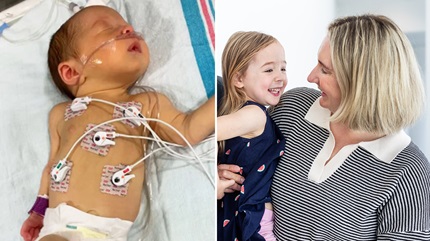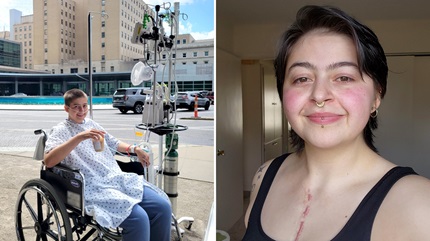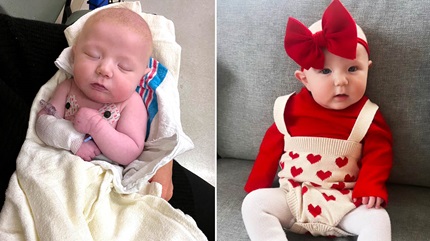Overview
World-class heart surgery at Cleveland Clinic Children’s is provided by Cleveland Clinic's Congenital Heart Surgery Team. Children and adults who are born with heart disease receive state-of-the-art diagnosis and treatment.
Congenital heart issues often require multiple surgeries over a patient’s lifetime. Our surgeons work with patients, their parents and a collaborative team of caregivers to determine the best course of treatment with the goal of providing optimal outcomes and improving the patient's quality of life.
Our Congenital Heart Surgery Team works as an integral part of Cleveland Clinic's Heart, Vascular & Thoracic Institute, a nationally ranked and internationally renowned leader in heart care. Our pediatric patients with congenital cardiac defects are provided continued care into their adult life for any recurring congenital issues and any future acquired heart disease.
We strive to improve the clinical outcomes of established surgical procedures and work to find innovative methods of treating difficult and complex conditions. Our team regularly uses advanced imaging techniques and 3D printed models to plan and execute complex surgical procedures and re-do procedures on patients who've had multiple surgical operations for their congenital heart disease.
We also have a robust fetal congenital program that provides prenatal consultations, supervised deliveries and emergent interventional and surgical care of newborn babies immediately after birth.
Cleveland Clinic Children's believes in providing easy accessibility for our congenital surgical patients and has an open door policy for in-person consultations, second opinions and virtual consultations for patients across the United States and internationally.
What we treat
- Anomalous left coronary artery from the pulmonary artery (ALCAPA).
- Anomalous pulmonary veins.
- Aortic valve disease.
- Aortic and mitral atresia.
- Aortopulmonary window.
- Arrhythmia surgery.
- Arterial switch operation.
- Atrial septal defects.
- Atrial isomerism.
- Atrioventricular canal.
- Cardiac tumors.
- Cardiomyopathy.
- Coarctation of the aorta.
- Complex congenital heart disease.
- Congenital coronary artery anomalies.
- Congenitally corrected transposition of great arteries (CCTGA).
- Coronary fistula.
- Cortriatriatum.
- Double outlet right ventricle.
- Ebstein’s anomaly.
- Genetic heart diseases.
- Heterotaxy syndrome.
- Hypertrophic cardiomyopathy.
- Hypoplastic left heart syndrome (HLHS).
- Interrupted aortic arch.
- Marfan syndrome.
- Mitral valve disease.
- Myocarditis acute and chronic.
- Patent ductus arteriosus.
- Patent foramen ovale.
- Pediatric cardiomyopathy.
- Pulmonary atresia.
- Pulmonary artery stenosis.
- Pulmonary hypertension.
- Pulmonary valve disease.
- Pulmonary vein stenosis.
- Scimitar syndrome.
- Single ventricle.
- Subaortic membrane.
- Tetralogy of Fallot (TOF).
- Total anomalous pulmonary venous return / connection Transposition of the great arteries (TGA).
- Tricuspid atresia.
- Truncus arteriosus.
- Vascular ring.
- Ventricular inversion.
- Ventricular septal defects.
- Univentricular heart.
Complex Biventricular Repairs
Accomplishing a biventricular repair is the primary goal of any surgical procedure on a congenital heart defect as it leads to a near normal anatomy and the long-term results are better than any univentricular repair. In some patients, this repair is not possible because of an inherent developmental defect.
Use of modern imaging techniques combined with the construction of 3D print models has made it so we can study the possibility of such complex intra-cardiac biventricular repairs. Our surgical team routinely uses this modern technology to plan and carry out such complex biventricular repairs both in newly-diagnosed patients and in patients who have previously undergone univentricular repair due to unavailability of these modern tools.
What we treat
- Heterotaxy syndromes.
- Left isomerism.
- Right isomerism.
- Borderline left ventricle.
- Borderline right ventricle.
- Shone’s complex.
- Complex intra-cardiac connections.
- Complex biventricular heart previously treated as univentricular heart.
Complex Aortic Root Surgery
For many reasons, surgery on the aortic valve and aortic root is particularly challenging in children. The small size of the aortic valve annulus, the limited options available for valve replacement and the need for continued valve growth are just a few of the causes. The presence of other congenital heart anomalies and multiple previous surgeries can also add to the complexity of the surgery.
Cleveland Clinic Children’s has vast experience with complex surgical procedures on the aortic root and specializes in performing the surgery on children who have had previous complex heart procedures. Many children require repeat procedures later in life as they outgrow their previous valves and our surgical team provides safer and lower risk options for these redo procedures.
Life-long care for connective tissue disorders
Children with connective tissue disorders like Marfan syndrome and William syndrome are provided life-long surveillance and surgical interventions, as required.
What we treat
- Aortic valve and aortic root endocarditis.
- Congenital aortic stenosis.
- Connective tissue disorders.
- Marfan syndrome.
- Narrow aortic root and left ventricular outflow tract.
- Need for Konno, Konno Rastan or Konno Ross procedure.
- Need for re-do surgery after multiple procedures on aortic root.
- Post-Ross aortic stenosis or neo-aortic regurgitation.
- Post-truncus repair aortic stenosis or aortic regurgitation.
- Post-Norwood surgery aortic stenosis or aortic regurgitation.
- Prosthetic valve dysfunction after aortic valve or aortic root replacement.
- Shone’s complex.
- William syndrome.
Congenital Coronary Anomalies
The heart needs a constant supply of oxygen and nutrients to maintain its pumping action. This supply comes from the right and left coronary arteries which ascend from the aorta and supply the heart muscle through their branches. A small percentage of children are born with anomalies in their coronary arteries. Some children might have no symptoms, while others may experience chest pain, palpitations, life-threatening arrhythmias or dizzy episodes, especially during strenuous activity.
When an abnormal coronary is suspected, a CT scan and an exercise test are initially required; a more detailed diagnosis is made with cardiac catheterization. A surgical intervention may be required to relieve symptoms, or if a life-threatening diagnosis is made. Our team has developed innovative surgical procedures to treat some of the most difficult and challenging congenital coronary anomalies.
Many individuals who are diagnosed with anomalies are young athletes who need advice and counselling about their ability to participate in competitive sports and Cleveland Clinic Children’s provides this service for our patients.
What we treat
- Anomalous origin of left coronary artery from pulmonary artery (ALCAPA).
- Anomalous origin of coronary artery from opposite sinus.
- Coronary artery fistulas.
- Intra-arterial course of coronary artery.
- Intramural right or left main coronary artery.
- Myocardial bridging of coronary artery.
- Trans-septal course of left coronary artery.




